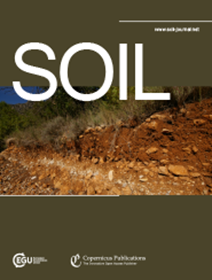Soil erosion in Mediterranean olive groves: a review
IF 4.3
2区 农林科学
Q1 SOIL SCIENCE
引用次数: 0
Abstract
Abstract. Olive groves are a defining feature of the Mediterranean landscape, economy, and culture. However, this keystone agroecosystem is under severe threat from soil erosion, a problem exacerbated by the region's unique topographic, climatic conditions and agricultural practices. Although soil erosion in olive groves has been extensively studied, significant uncertainties remain due to the high variability of scales and measurement methods. Knowledge gaps persist regarding the average soil loss rates and runoff coefficients as well as the effects of different management approaches and the influence of triggering factors on soil erosion rates. So far, an effort to quantify this effect on Mediterranean olive cultivation has not been made comprehensively. Therefore, the aim of this literature review is to discern clearer patterns and trends that are often obscured by the overall heterogeneity of the available data. By systematically analysing the data according to measurement methodology, this review provides clear answers to these knowledge gaps and reveals a consistent narrative about the primary drivers of soil loss. While natural factors like topography, rainfall intensity and soil properties establish a baseline risk, this review shows that agricultural management, particularly the presence of groundcovers, is the pivotal factor controlling soil degradation. The long-standing debate on erosion severity is largely reconciled by the finding that reported rates are highly dependent on the measurement methodology, and hence on the spatial and temporal scale. Conservation practices consistently reduce soil loss by more than half, an effect far more pronounced for sediment control than for runoff reduction. Ultimately, the path to sustainability requires a shift away from conventional tillage and bare-soil management towards the widespread adoption of vegetation/groundcover, driven by effective policies and a commitment to multi-scale and multi-proxy research to improve predictive models.地中海橄榄园土壤侵蚀研究进展
摘要。橄榄林是地中海景观、经济和文化的标志性特征。然而,这一重要的农业生态系统正受到土壤侵蚀的严重威胁,该地区独特的地形、气候条件和农业实践加剧了这一问题。尽管对橄榄园的土壤侵蚀进行了广泛的研究,但由于尺度和测量方法的高度可变性,仍然存在显著的不确定性。关于平均土壤流失率和径流系数,以及不同管理方法的影响和触发因素对土壤侵蚀率的影响,知识差距仍然存在。到目前为止,还没有全面量化这种对地中海橄榄种植的影响。因此,本文献综述的目的是辨别更清晰的模式和趋势,这些模式和趋势往往被可用数据的整体异质性所掩盖。通过根据测量方法系统地分析数据,本综述为这些知识空白提供了明确的答案,并揭示了关于土壤流失主要驱动因素的一致叙述。虽然地形、降雨强度和土壤性质等自然因素确定了基线风险,但这一综述表明,农业管理,特别是地被植物的存在,是控制土壤退化的关键因素。关于侵蚀严重程度的长期争论在很大程度上得到了调和,因为报告的速率高度依赖于测量方法,因此依赖于空间和时间尺度。保护措施始终使土壤流失减少一半以上,控制泥沙的效果远比减少径流的效果明显。最终,可持续发展的道路需要从传统的耕作和裸土管理转向广泛采用植被/地被覆盖,这需要有效的政策和致力于多尺度和多代理研究来改进预测模型。
本文章由计算机程序翻译,如有差异,请以英文原文为准。
求助全文
约1分钟内获得全文
求助全文
来源期刊

Soil
Agricultural and Biological Sciences-Soil Science
CiteScore
10.80
自引率
2.90%
发文量
44
审稿时长
30 weeks
期刊介绍:
SOIL is an international scientific journal dedicated to the publication and discussion of high-quality research in the field of soil system sciences.
SOIL is at the interface between the atmosphere, lithosphere, hydrosphere, and biosphere. SOIL publishes scientific research that contributes to understanding the soil system and its interaction with humans and the entire Earth system. The scope of the journal includes all topics that fall within the study of soil science as a discipline, with an emphasis on studies that integrate soil science with other sciences (hydrology, agronomy, socio-economics, health sciences, atmospheric sciences, etc.).
 求助内容:
求助内容: 应助结果提醒方式:
应助结果提醒方式:


